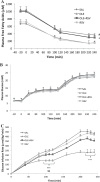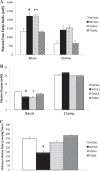Pharmacologic or genetic activation of SIRT1 attenuates the fat-induced decrease in beta-cell function in vivo
- PMID: 30890694
- PMCID: PMC6424971
- DOI: 10.1038/s41387-019-0075-z
Pharmacologic or genetic activation of SIRT1 attenuates the fat-induced decrease in beta-cell function in vivo
Abstract
Background: There is evidence that sirtuin 1 (SIRT1), a key regulator of nutrient metabolism, increases β-cell secretory function. Excess circulating fat, as seen in obesity, has been shown to decrease β-cell function, an effect that may involve decreased SIRT1 activity. Consequently, SIRT1 activation may increase β-cell function in conditions of elevated plasma-free fatty acid levels. Here we attempted to attenuate the lipid-induced decrease in β-cell function in vivo using pharmacological and genetic models of SIRT1 activation.
Methods: Our pharmacologic model involved 48 h intravenous infusion of Wistar rats with either saline or oleate with or without the SIRT1 activator resveratrol. Additionally, we used β-cell-specific SIRT1 overexpressing (BESTO) mice and wild-type littermates infused for 48 h intravenously with either saline or oleate. In both models, the infusion period was followed by assessment of β-cell function using the hyperglycemic clamp method.
Results: Lipid infusion resulted in a significant decrease in β-cell function as expected in both rats (p < 0.05) and mice (p < 0.001). Both models of SIRT1 activation, which did not alter β-cell function in the absence of fat, resulted in partial protection from the fat-induced decrease in β-cell function (NS vs. control).
Conclusion: These results suggest that SIRT1 is a therapeutic target in decreased β-cell function specifically induced by fat.
Conflict of interest statement
The authors declare that they have no conflict of interest.
Figures




Similar articles
-
IKKβ inhibition prevents fat-induced beta cell dysfunction in vitro and in vivo in rodents.Diabetologia. 2017 Oct;60(10):2021-2032. doi: 10.1007/s00125-017-4345-9. Epub 2017 Jul 20. Diabetologia. 2017. PMID: 28725915
-
Sirtuin 1 independent effects of resveratrol in INS-1E β-cells.Chem Biol Interact. 2017 Feb 25;264:52-60. doi: 10.1016/j.cbi.2017.01.008. Epub 2017 Jan 17. Chem Biol Interact. 2017. PMID: 28108221
-
Resveratrol ameliorates endothelial dysfunction in diabetic and obese mice through sirtuin 1 and peroxisome proliferator-activated receptor δ.Pharmacol Res. 2019 Jan;139:384-394. doi: 10.1016/j.phrs.2018.11.041. Epub 2018 Nov 29. Pharmacol Res. 2019. PMID: 30503839
-
β-Cell Insulin Resistance Plays a Causal Role in Fat-Induced β-Cell Dysfunction In Vitro and In Vivo.Endocrinology. 2024 Mar 29;165(5):bqae044. doi: 10.1210/endocr/bqae044. Endocrinology. 2024. PMID: 38578954 Free PMC article.
-
SIRT1 and insulin resistance.J Diabetes Complications. 2016 Jan-Feb;30(1):178-83. doi: 10.1016/j.jdiacomp.2015.08.022. Epub 2015 Sep 2. J Diabetes Complications. 2016. PMID: 26422395 Review.
Cited by
-
Nicotinamide Mononucleotide Prevents Free Fatty Acid-Induced Reduction in Glucose Tolerance by Decreasing Insulin Clearance.Int J Mol Sci. 2021 Dec 8;22(24):13224. doi: 10.3390/ijms222413224. Int J Mol Sci. 2021. PMID: 34948019 Free PMC article.
-
Sirt1-PPARS Cross-Talk in Complex Metabolic Diseases and Inherited Disorders of the One Carbon Metabolism.Cells. 2020 Aug 11;9(8):1882. doi: 10.3390/cells9081882. Cells. 2020. PMID: 32796716 Free PMC article. Review.
-
Proposed Tandem Effect of Physical Activity and Sirtuin 1 and 3 Activation in Regulating Glucose Homeostasis.Int J Mol Sci. 2019 Sep 25;20(19):4748. doi: 10.3390/ijms20194748. Int J Mol Sci. 2019. PMID: 31557786 Free PMC article. Review.
-
Exploring histone deacetylases in type 2 diabetes mellitus: pathophysiological insights and therapeutic avenues.Clin Epigenetics. 2024 Jun 11;16(1):78. doi: 10.1186/s13148-024-01692-0. Clin Epigenetics. 2024. PMID: 38862980 Free PMC article. Review.
-
Effects of Obesogenic Feeding and Free Fatty Acids on Circadian Secretion of Metabolic Hormones: Implications for the Development of Type 2 Diabetes.Cells. 2021 Sep 3;10(9):2297. doi: 10.3390/cells10092297. Cells. 2021. PMID: 34571945 Free PMC article. Review.
References
Publication types
MeSH terms
Substances
Grants and funding
LinkOut - more resources
Full Text Sources
Medical
Miscellaneous

